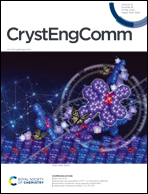Controllable synthesis, characterization and photoluminescence properties of flower-like BaMoO4 hierarchical architectures†
Abstract
Flower-like BaMoO4 hierarchical architectures were successfully prepared by a facile solvothermal route. The influences of reaction time and various solvents on the morphology, structure, and performance of the samples were studied in detail. A nucleation–oriented attachment–self-assembly–Ostwald ripening mechanism is presented for the formation of the flower-like BMO HAs. X-ray diffraction, scanning electron microscopy, transmission electron microscopy, and UV-vis spectroscopy were applied to characterize the structure, morphology, and optical properties of the as-synthesized products. The results reveal that the products have a well-crystallized scheelite tetragonal structure with good dispersion and uniformity. The photoluminescence (PL) properties of the products were all detected at room temperature. The PL spectra show that all the products have two distinct emission peaks and a strong ultraviolet (UV) emission in the UV region, indicating that the synthesized BMO products have a great potential application in photoluminescence areas. The synthetic route is simple, and can also be used to prepare other molybdates and related inorganic materials with specific morphology and structure by adjusting the synthetic parameters.



 Please wait while we load your content...
Please wait while we load your content...